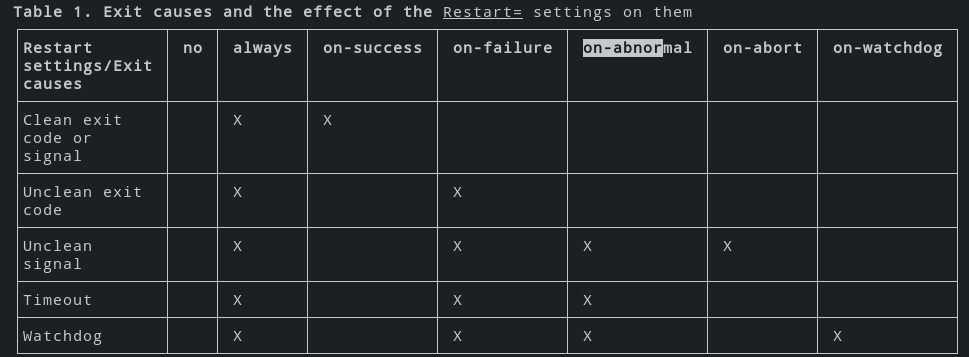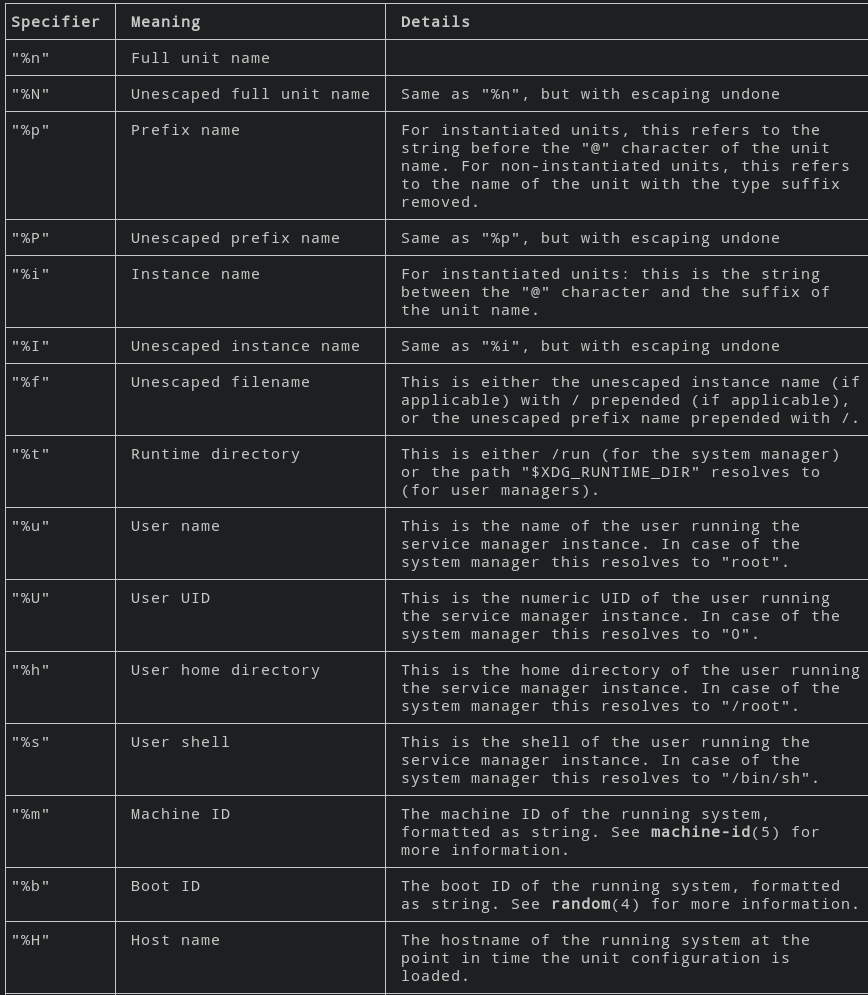Newly Setting up a CentOS-7 system
yum install -y epel-release glibc.i686 libtools vim clang git autoconf automake w3m glibc screen
the most import sentence I learned in meeting compiling prerequisites:
yum whatprovides */libcap* | grep dev
in *nix systems, the concept of runlevel is always met, and some softwares needs to do some changes in the relative folders.. /etc/rc3.d/..
here are some quotes from askubuntu..:
<QUOTE>{
To see the current (and previous) runlevel:
runlevel
To switch runlevels:
sudo init $runlevel
For example, to reboot:
sudo init
The init you are reading about was replaced by upstart starting with Edgy Eft 6.10; and, one of the programs provided by upstart is its own implementation of init. Here are the docs for 10.04.
To change the default runlevel, use your favorite text editor on /etc/init/rc-sysinit.conf...
sudo vim /etc/init/rc-sysinit.conf
Change this line to whichever runlevel you want...
env DEFAULT_RUNLEVEL=
Then, at each boot, upstart will use that runlevel.
}</QUOTE>
and note that the default runlevel of systems is 3 usually..
some init files..
~/.profile /etc/profile ~/.xprofile : things to do when login in graphical mode, /etc/profile is for all users
~/.bash_profile :things to do when login as personal user in bash/sh/rxvt/urxvt.
~/.bashrc : things to do when opening new bash/sh/rxvt/urxvt, open ssh, scp, sudo
~/.xinitrc : things to do when starting x server
~/.i3/config : things to do when starting i3
----orignal file above-- here are contents updated Sept. 26, 2017----
to start something while startup have several ways, one is to add a service at path /usr/lib/systemd/system/
a service file usually seems like:
[Unit]
Description=...
Documentation=man:..(id) man:..(id)
After=
Wants= [Service]
Type=
PIDFile=
EnvironmentFile
ExecStart=
ExecReload=
KillMode=
Restart=on-failure
RestartSec= [Install]
WantedBy=
to know more about the [Service] part of a service file, see man systemd.service. Other parts contains: man systemd.unit, man systemd.exec, man systemd.kill, man systemd.resource-control
some interesting [Service] settings:
Type, here specifies type of the service. Choices can be one of: simple, forking, oneshot, notify, dbus, idle.
quote from here, types have the following meaning:
Type=simple(default): systemd considers the service to be started up immediately. The process must not fork. Do not use this type if other services need to be ordered on this service, unless it is socket activated.Type=forking: systemd considers the service started up once the process forks and the parent has exited. For classic daemons use this type unless you know that it is not necessary. You should specifyPIDFile=as well so systemd can keep track of the main process.Type=oneshot: this is useful for scripts that do a single job and then exit. You may want to setRemainAfterExit=yesas well so that systemd still considers the service as active after the process has exited.Type=notify: identical toType=simple, but with the stipulation that the daemon will send a signal to systemd when it is ready. The reference implementation for this notification is provided by libsystemd-daemon.so.Type=dbus: the service is considered ready when the specifiedBusNameappears on DBus's system bus.Type=idle: systemd will delay execution of the service binary until all jobs are dispatched. Other than that behavior is very similar toType=simple.
ExecStart, ExecStop (either one should be specified, or the service file is illegal) is executable is prefixed with '-', then an exit code of command usually is considered as failure is ignored and considered success. If prefixed with '+', then it is executed with full privilege. If file prefixed with '@', then second token be passed as argv[0] to process. All the three prefixes can be used together.
ExecStartPre, ExecStartPost (any of the above commands fails, the service is stopped heresince and considered a failure, and continues with commands specified in ExecStopPost. ExecStop commands will also be skipped. (It is not started)
ExecStop, this command should be one that synchronously stops the process running.
RuntimeMaxSec, WatchdogSec(this should be used together with Type=Notify, NotifyAccess=main/all/.., otherwise it is defaults to 0/forever)
Restart, on-success, on-failure, no, on-abnormal, on-watchdog, on-abort, always.
RestartSec, specifies the seconds that waits before restart the service.

Some [Unit] settings:
Wants, Requires, Requisite, BindsTo: services Requires will be started as well when this service is started(list order is of-no-importance when being started), however, if services Requisite not running while starting this service, the start process will be failed. Wants services will also be started when this service starts, but this service will not be failed immediately when wanted services fails. When BindsTo services stopped, this service will be stopped also.
PartOf: when the specified services being started, this service will also be started, similar to Requires
Before, After, this service is before/after the mentioned services when being started, and also when stops, the inverse ordering is applied
OnFailure, services to be run when fails
ConditionArchitecture, ConditionVirtualization, ConditionHost, ConditionKernelCommandLine, ConditionPathExists, ConditionFileNotEmpty,
Some [Install] settings: the settings here be affecting systemctl enable commands
Alias,
WantedBy, RequiredBy, reverse form of Wants, Requires. But in order to take effect, this service should be enabled by systemctl enable and thus symlinks is created in the wants folder.
some services can be started as multiple instances, these are services end up like "name@.service", when start an instance of such service, use systemctl start name@helloworld1.service, where the helloworld1 part is the name of the instance.. and can be reached inside the service file by using %i. Here are all the escapers listed in man systemd.unit..


Service variables:
$MAINPID, $SERVICE_RESULT, $EXIT_CODE, $EXIT_STATUS
Newly Setting up a CentOS-7 system的更多相关文章
- 编写CentOS的System V init启动脚本
系统本身自带了说明,在/usr/share/doc/initscripts-(*)/sysvinitfiles,内容如下: 所有System V init脚本都命名为/etc/rc.d/init.d/ ...
- linux mysql无故无法启动了,centos 7
转自: http://support.moonpoint.com/software/database/mysql/not-running-centos7.php 下面简单翻译一下. 详细内容可以阅读英 ...
- centos 7 上安装 testlink 1.9.15/1.9.16/1.9.17/1.9.18 (mysql/php/httpd)
1.9.18 的System Requirements - server.注意,适用于 1.9.15 及以后. Server environment should consist of: web-se ...
- CentOS 7上更改MySQL数据库存储目录浅析
个人之前总结过两篇文章"MySQL更改数据库数据存储目录"和"Ubuntu上更改MySQL数据库数据存储目录",都是在工作中遇到相关案例后的一个简单总结.当 ...
- 转:CentOS/Debian/Ubuntu一键安装LAMP(Apache/MySQL/PHP)环境
CentOS/Debian/Ubuntu一键安装LAMP(Apache/MySQL/PHP) 今天遇到一个网友提到需要在Linux VPS服务器中安装LAMP(Apache/MySQL/PHP)网站环 ...
- 使用dnsmasq来提升CentOS上网速度
1. 安装dnsmasq dnsmasq的官方网址是:http://www.thekelleys.org.uk/dnsmasq/doc.html.利用里面的下载链接下载dnsmasq-2.72.tar ...
- Install FFMPEG and FFMPEG-PHP in CentOS 6 with Virtualmin
Install FFMPEG and FFMPEG-PHP in CentOS 6 with Virtualmin 1 year ago - by Daniel - howto centos v ...
- CentOS 7 install slurm cluster
//slurm install //CentOS 7 system //192.168.159.141 node01 //192.168.159.142 node02 systemctl stop f ...
- CentOS 7 单用户模式+救援模式
CentOS 7 单用户模式+救援模式 CentOS 7 单用户模式+救援模式.有时候大家可能会忘记自己的root密码,或者错误(命令输入错误,命令位置输入有误等)编辑了一个/etc目录下的核心文件导 ...
随机推荐
- hdu_5900_QSC and Master(区间DP)
题目链接:hdu_5900_QSC and Master 题意: 有n个数,每个数有个key值,有个val,如果相邻的两个数的key的gcd大于1那么就可以得到这两个数的val的和,现在问怎么取使得到 ...
- linux命令readlink
readlink,从字面意思就可以看出来,输出符号链接值或者权威文件名. openwrt 下的readlink命令参数如下: root@hbg:/# readlink --helpBusyBox v ...
- hellobruce
- 【2】docker 与UFW
ufw是一个主机端的iptables类防火墙配置工具. 1.查看ufw的状态:ufw status 2.如果使用UFW,需要对其进行修改才能让DOCKER工作.docker使用一个网桥来管理容器中的网 ...
- Bitcode问题
原因:Xcode7 及以上版本会默认开启 bitcode .bitcode具体是什么就不解释了.解决方法:1.更新library使包含Bitcode,否则会出现以上的警告.2.关闭Bitcode,简单 ...
- 第四十二节,configparser特定格式的ini配置文件模块
configparser用于处理特定格式的文件,其本质上是利用open来操作文件. 特定格式的ini配置文件模块,用于处理ini配置文件,注意:这个ini配置文件,只是ini文件名称的文本文件,不是后 ...
- simHash 简介以及java实现
http://gemantic.iteye.com/blog/1701101 simHash 简介以及java实现 博客分类: 算法 simHash java 去重 传统的hash 算法只负责将原始 ...
- nefu 753 n!末尾有多少个0
Problem : 753 Time Limit : 1000ms Memory Limit : 65536K description 计算N!末尾有多少个0 input 输入数据有多组,每组1行,每 ...
- text-size-adjust的值为100% 代替值 none
iPhone 横屏默认会放大文字,设置text-size-adjust会解决这个问题 一般用text-size-adjust:none 但建议用100%代替none text-size-adjust: ...
- 今天遇到了隐藏顶部菜单栏(top bar)的菜鸟问题,解决了。
self.navigationController.navigationBarHidden = YES; http://stackoverflow.com/questions/3397381/hide ...
